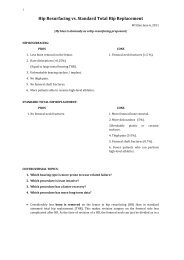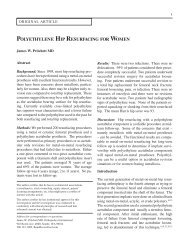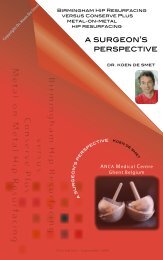Hip and Knee Arthroplasty - Surface Hippy Guide to Hip Resurfacing
Hip and Knee Arthroplasty - Surface Hippy Guide to Hip Resurfacing
Hip and Knee Arthroplasty - Surface Hippy Guide to Hip Resurfacing
Create successful ePaper yourself
Turn your PDF publications into a flip-book with our unique Google optimized e-Paper software.
knee increased from 29.4% in 2003 <strong>to</strong> 32.1% in<br />
2007 (Figure KG2).<br />
Diagnosis<br />
The indication for almost all primary knee<br />
replacement procedures is osteoarthritis (partial<br />
resurfacing 90%, unispacer 100%,<br />
patella/trochlear 98.9%, uni-compartmental<br />
98.8%, bicompartmental 100% <strong>and</strong> primary <strong>to</strong>tal<br />
96.8%). The principal cause for revision knee<br />
replacement is loosening (36.5%).<br />
Use of different Categories of <strong>Knee</strong><br />
Replacement<br />
The most common knee procedure is a primary<br />
<strong>to</strong>tal knee replacement (78.7% of all knee<br />
procedures recorded by the Registry). The<br />
proportion of other knee procedures is 12.2% for<br />
unicompartmental, 0.5% for patella/trochlear <strong>and</strong><br />
8.5% for revision procedures. There is a small<br />
number of procedures recorded for the other<br />
types of primary knee replacement, partial<br />
resurfacing (90), unispacer (39) <strong>and</strong><br />
bicompartmental (42) (Table KG1).<br />
The proportion of all knee replacements that are<br />
primary <strong>to</strong>tal knee replacements has increased<br />
each year from 77.2% in 2003 <strong>to</strong> 82.0% in 2007.<br />
The proportion of unicompartmental knees has<br />
decreased from a high of 14.6% in 2003 <strong>to</strong> 9.7%<br />
in 2007. The proportion of knee replacements<br />
that are revision procedures is the same in 2007<br />
as it was in 2003 (8.2%) (Figure KG3).<br />
State <strong>and</strong> Terri<strong>to</strong>ry Variation in Use<br />
There is some regional variation in the<br />
proportional use of the different knee<br />
procedures. All states however have shown a<br />
decrease in the use of unicompartmental knee<br />
procedures since 2003. Tasmania is the only<br />
state <strong>to</strong> show a small increase in the use of this<br />
type of prosthesis in 2007 compared <strong>to</strong> 2006<br />
(Figure KG3).<br />
Bilateral Primary <strong>Knee</strong> Replacement<br />
The Registry definition of a bilateral procedure is<br />
when an individual has undergone primary knee<br />
replacement on both knees regardless of the type<br />
of primary knee replacement or the timing of the<br />
second knee operation. Within five years 21.2%<br />
of patients have undergone bilateral knee<br />
replacement.<br />
The Registry has recorded 32,695 individuals<br />
with bilateral knee procedures, 25.5% of these<br />
were performed on the same day. The most<br />
common same day bilateral knee replacement is<br />
bilateral primary <strong>to</strong>tal knee replacement. This<br />
combination of knee replacement accounts for<br />
77.8% of all same day bilateral procedures. Of<br />
the remaining same day bilateral procedures<br />
18.5% are bilateral unicompartmental knee<br />
replacements (Table KG3).<br />
General Comparison of Outcomes<br />
The main outcome of the Registry is the time <strong>to</strong><br />
first revision of a primary joint replacement. The<br />
outcomes of procedures are measured in two<br />
ways, using the number of revisions per 100<br />
observed component years <strong>and</strong> using the<br />
cumulative percent revision at specified time<br />
points (see Appendix 1 for the full definition).<br />
Primary <strong>to</strong>tal knee replacement has the lowest<br />
rate of revisions per 100 observed component<br />
years when comparing all primary knee<br />
procedures (primary <strong>to</strong>tal 0.8, unicompartmental<br />
1.9, patella/trochlear 3.1, <strong>and</strong> unispacer 36.0).<br />
The two new categories of primary knee<br />
replacement reported this year are partial<br />
resurfacing <strong>and</strong> bicompartmental primary knee<br />
replacement. Both have higher rates of revision<br />
per 100 observed component years compared <strong>to</strong><br />
all other primary procedures other than the<br />
unispacer (partial resurfacing 7.5 <strong>and</strong><br />
bicompartmental 21.7) (Table KG4).<br />
Comparison of the cumulative percent revision<br />
further highlights the difference in the risk of<br />
revision for each of these procedures. At seven<br />
years the cumulative percent revision of primary<br />
<strong>to</strong>tal knee procedures is 4.3% <strong>and</strong><br />
unicompartmental is 12.1%. The other<br />
procedures do not have seven year follow up,<br />
however the five year cumulative percent revision<br />
for patella/trochlear procedures is 13.8%, three<br />
year cumulative percent revision for unispacer<br />
procedures is 66.7% <strong>and</strong> for the two newly<br />
reported primary procedures, partial resurfacing<br />
is 16.5% at two years <strong>and</strong> bicompartmental is<br />
10.2% at one year (Table KG5).<br />
Outcome by Diagnosis<br />
As with primary hip replacement, the Registry is<br />
presenting outcomes related <strong>to</strong> primary diagnosis<br />
for the first time. Only primary <strong>to</strong>tal knee<br />
replacement has been included in this analysis as<br />
primary partial knee replacement is almost<br />
entirely performed for osteoarthritis.<br />
The outcomes of the four most common<br />
diagnoses for primary <strong>to</strong>tal knee replacement<br />
were compared using osteoarthritis as the<br />
compara<strong>to</strong>r diagnosis. Rheuma<strong>to</strong>id arthritis had<br />
the lowest revision rate <strong>and</strong> the risk of revision is<br />
significantly less than for osteoarthritis. There is<br />
no difference in the risk of revision for avascular<br />
necrosis <strong>and</strong> other inflamma<strong>to</strong>ry arthritis<br />
compared <strong>to</strong> osteoarthritis (Tables KG6 <strong>and</strong> KG7<br />
<strong>and</strong> Figure KG4).<br />
111






